20 Products From The Intel Solutions Summit That Are Powering Sales For Partners

Intel, Partner Products On Display
From small form-factor products to connected devices, Intel and its channel partners showcased an array of applications at this year's Intel Solutions Summit (ISS), which kicked off this week in Dallas.
Intel has looked to expand beyond the PC market into new areas like the Internet of Things – and this shift was apparent on the Santa Clara, Calif.-based chip giant's showcase at its partner conference.
Attendees got a glimpse of what Intel and its channel are bringing to market with Intel's Compute Card, what kind of innovation Intel is enabling around its data center products, and how partners can leverage products to bring IoT solutions to market.
Here are 20 cool products and solutions on display at ISS this year.
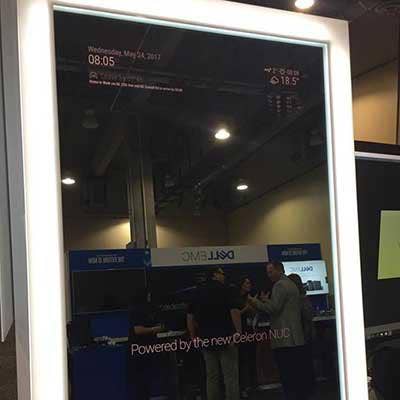
Smart Mirror Powered By NUC
An Intel-designed smart mirror at ISS showcased how partners can bring its newest Next Unit of Compute (NUC) mini-PC model to market in an innovative and fun way.
This mirror, powered by Intel's NUC, has the compute power to transform it to a connected object that shows information on the screen such as the date, weather, and how long it takes to get to work. The smart mirror, powered by the quad-core Apollo Lake-based Celeron processor, is still in the prototype phase, according to an Intel spokesperson.
Intel released its newest NUC in January. It runs on Windows 10 Home, and comes at a recommended price of $215.
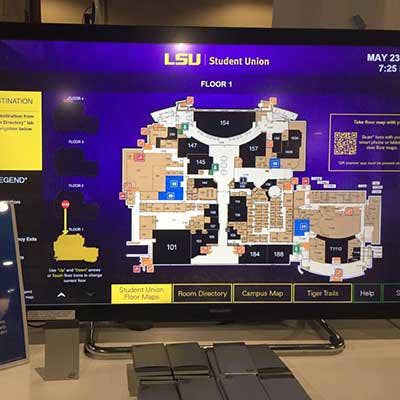
Compute Card Interactive Signage
Sharp used Intel's Compute Card to power an interactive digital signage solution. The example used on Intel's show floor helped university students navigate different floor maps on a campus, along with room directories, campus maps, and other trails using an interactive map, which they can then scan and view on a smartphone or tablet.
With the solution, users can provide easy servicing and upgrades through the Compute Card. Sharp's interactive signage application will be available as a solution in the fourth quarter of 2017.
Intel lifted the curtain on the Compute Card in January. The 5mm-thick product, which will be released in mid-2017, is already released to channel partners to power the next generation of Intel-based Internet of Things devices.
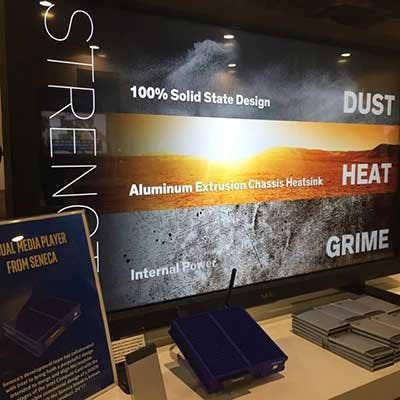
Seneca Visual Media Player
Seneca showed off its own application for a Compute Card – a visual media player. The company's development team said it has collaborated with Intel to "merge and align the modular advantages of the Intel Compute Card." The company used it to power a DOOH (digital out of home) display system, converting it into a visual media player for consumers.
The product will be available in the second half of 2017, according to Seneca.
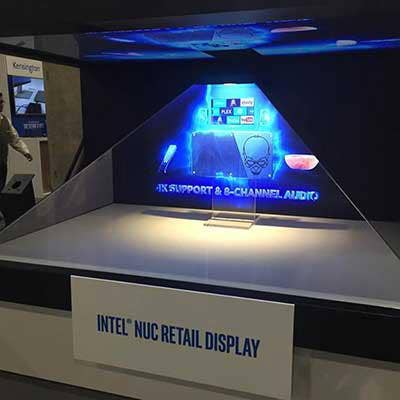
NUC Retail Display
On its show floor, Intel displayed how its Skull Canyon NUC can be applied to the retail market through the NUC retail display. This technology adds visually appealing components to an actual product on display, with support for 4K and 8-channel audio features. Intel's Skull Canyon mini PC, geared toward digital signage, media centers and kiosk solutions, packs a sixth-generation Intel Core i7-6770HQ processor.
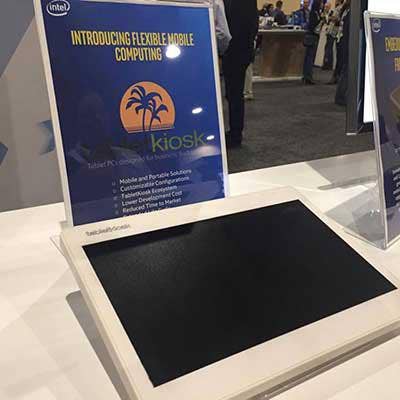
TabletKiosk Mobile Computing
Intel system builder TabletKiosk showed off another use case for the Compute Card – flexible mobile computing. The partner's tablet PC is built for mobile and portable solutions and features customizable configurations. Due in part to the Compute Card, this tablet PC has a lower development cost and reduced time to market. TabletKiosk, which is in the early stages of a prototype phase for its Compute Card solutions, is also equipping HD X-ray machines with Compute Cards so that customers don't have to retool their whole machines if they want to upgrade.
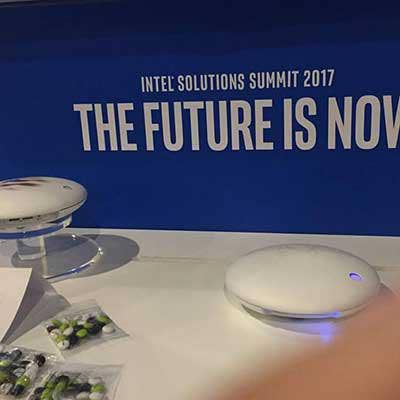
SiComputer Mini PC
SiComputer displayed its "Disco 360" mini PC at ISS. This mini PC, based on the Intel NUC board NUC7i3BNB, runs on a seventh-generation Core i3 processor.
Intel partner SiComputer offers an array of mini PCs, including the Activa Stick, to transform any TV or monitor into a PC for home or business, and Embedded OPS for developing digital signage technologies.
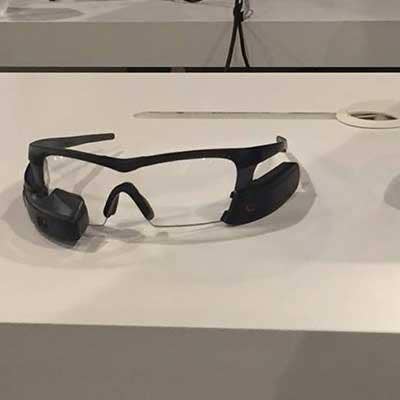
Recon Jet
Recon Jet, which Intel acquired in 2015, showed off its manufacturing solution for the connected workforce – augmented reality-based goggles to help workers on the manufacturing and industrial floor perform hands-free tasks easily. By wearing the Recon Jet Pro glasses, workers can help shorten task-completion times, accelerate employee training, and minimize downtime in the industrial market.
The glasses display features micro LCD and connectivity like Bluetooth, Wi-Fi and GPS to offer users computing and software that help them view data, tasks and video calls while they're working. These connected goggles are currently on the market and available through Jet Pro distributors.
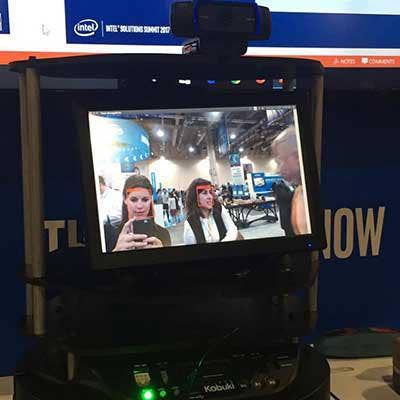
Kobuki Robot with Joule
Intel in August unveiled its new Joule module that powers robotics, drones and IoT applications, and at ISS, partners got a view of the module in action.
Yujin Robot's Kobuki base is powered by the Joule module and now features capabilities like facial recognition and tracking for surveillance and security purposes.
Intel's Joule module features high-end compute, 4K video and large memory capabilities, as well as support for RealSense technology and other Intel software tools.
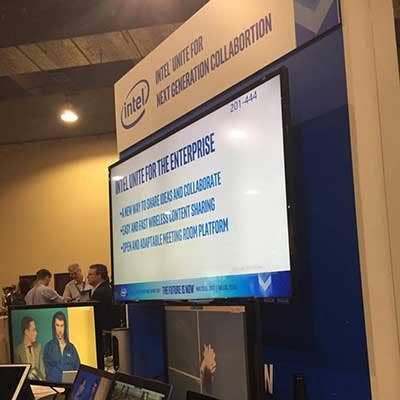
Intel Unite
Intel displayed its Unite conferencing software, which the company upgraded in February. Unite has been offered to businesses as a cost-effective and manageable platform for connecting meeting spaces. In its newest version of Unite, Intel said it wanted to extend the platform beyond the office and into new vertical markets, such as classrooms and retail stores. Intel Unite is currently available to partners.
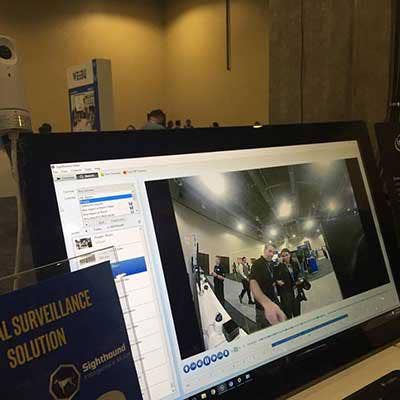
NUC Digital Surveillance
Intel demonstrated how it's collaborating with partners – in this case Sighthound and Vivotek – to make its NUC mini PC available as a digital surveillance solution to customers.
The NUC powered a Vivotek IP surveillance camera and used computer vision technology provided by surveillance software company Sighthound. This solution helps customers monitor their homes or businesses using the NUC kit NUC7i5BNH. According to Intel, Sighthound's technology, which is normally deployed only for government agencies, can detect certain facial features.
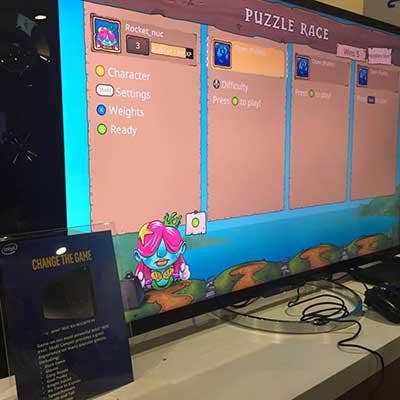
NUC Gaming
The NUC has another important application for Intel's partner base: gaming. Intel showed how a Skull Canyon NUC kit NUC6i7KYK could help enthusiasts power their favorite games on monitors. The company said that Skull Canyon provides a visually enhanced experience on many popular games, including Knight Squad, Skyrim and Speed Runners.
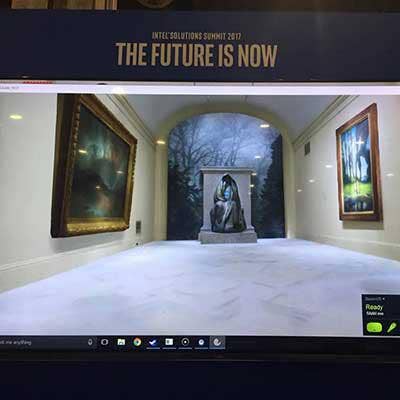
Intel Smithsonian VR display
Intel showed off its virtual reality expertise through a VR recreation of the Smithsonian American Art Museum. This virtual reality exhibit allows users to step into a virtual rendition of the museum, and then teleport into a virtual 360-degree recreation of the paintings themselves.
Intel collaborated with Framestore and Valis Studios to map out the content for the virtual museum floor.
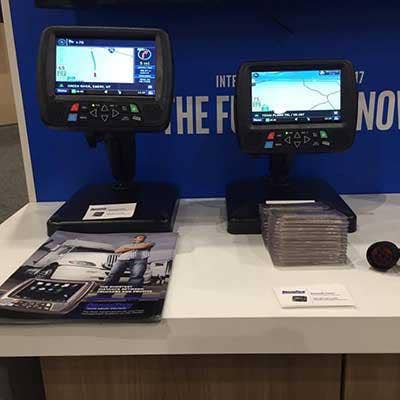
Fleet Management and Telematics Solutions
Intel partnered with DriverTech to create all-in-one systems for drivers and fleet management controls. This lineup of systems features a driver-optimized touchscreen and a "driver-friendly display." In addition, the system contains over 200 telematic metrics for drivers, advanced driver assistance, precise truck navigation, and a front-facing video event recorder.
DriverTech's system, which packs an Intel processor, is currently on the market.
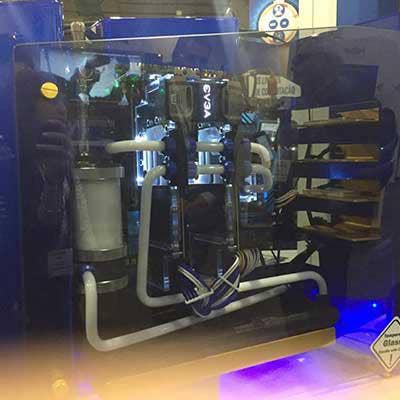
Live 360 Streaming Video
Intel demonstrated a Live 360-degree video stitching and transcoding solution. This technology integrates visuals from a 360-degree camera so that users can view pictures from different angles. Intel has touted its 360-degree live-streaming technology over the past year as a way to watch live games – including NBA games. Users can enhance their experience with 360-degree streaming video using a virtual reality headset, such as Oculus Rift, making them feel as though they're right at courtside during live games.
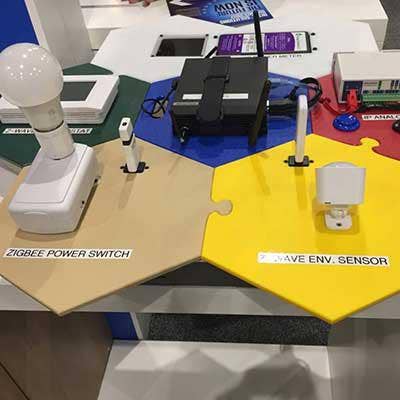
Intel Building Management Platform
Intel showcased its building management platform to partners, which makes it easier to connect building systems to the cloud. The platform integrates data and device management tools from CANDI Controls to help customers power cloud-based smart building applications through devices like air conditioning units, thermostats, meters, lighting controls, switches, and video cameras.
Intel said its platform integrates with protocols like Zigbee, Insteon and IP.
Through Intel's Building Management Platform, partners can help their customers manage over-the-air updates and better security protection. The platform is currently on the market and can be integrated with third-party analytics solutions, according to an Intel spokesperson.
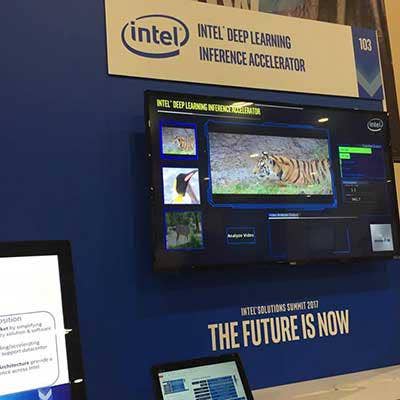
Intel Deep Learning Accelerator
Intel gave partners a deeper look into its artificial intelligence Nervana platform through a demonstration of its Deep Learning Inference Accelerator, which serves as a turnkey solution for image recognition.
Through field-programmable gate arrays (FPGAs), the chip giant is able to power several artificial intelligence applications in the financial services, surveillance and security, healthcare and retail markets, as well as advanced driver assistance systems. The accelerator integrates software frameworks such as Intel's Math Kernel Library for Deep Neural Networks for programming at the software level. Meanwhile, the PCIe-based accelerator card increases throughput and power efficiency, enabling machines to learn and recognize images.
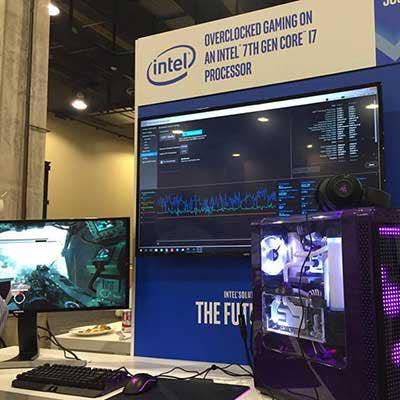
Intel's Enthusiast Platform
Intel displayed the enthusiast capabilities of its seventh-generation Kaby Lake processors through an overclocked gaming demonstration featuring a Core i7 processor.
Intel’s 14-nm processors pack a 12 percent increase in productivity over its sixth-generation Core processor, and has 10 times the performance and power efficiency over its first-generation Core processor, Intel said.
For partners in the enthusiast PC space, that's another reason for customers to upgrade their desktops with Intel's newest generation of processors. The Kaby Lake lineup for enthusiast applications is currently on the market.
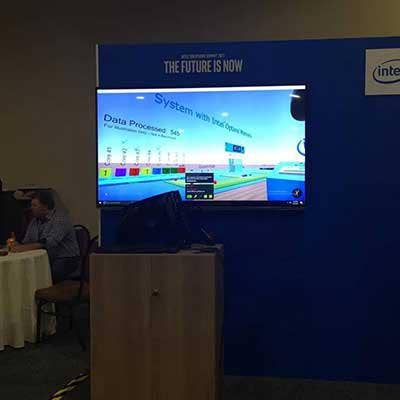
Intel Commercial Training
In addition to its virtual Smithsonian Museum display, Intel demonstrated another application for virtual reality – commercial training. At Intel's Commercial Training booth, show-goers could use a virtual reality headset to learn how systems work with or without Optane memory, showing how VR has good educational uses for training purposes.
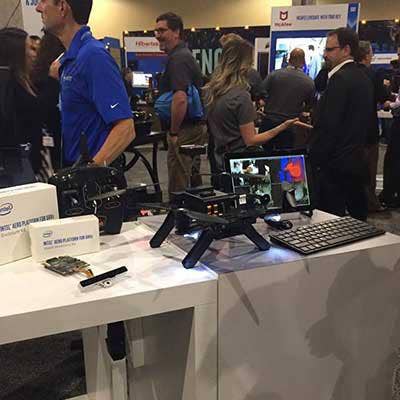
Intel UAV Platform
Intel demonstrated one cool use case for its RealSense spacial technology through its Aero platform for unmanned aerial vehicles (UAV), including drones. The company's developer platform is built for UAV applications with support for Intel's RealSense technology and a quad-core Intel Atom processor.
Through Intel's UAV platform and RealSense, drones can identify and avoid obstacles. The platform's centerpiece product is the Intel Aero Ready To Fly Drone, which features a pre-programmed flight controller with Dronecode PX4 software, and which runs on the open-source Linux OS. Both the platform and drone are currently available to partners.
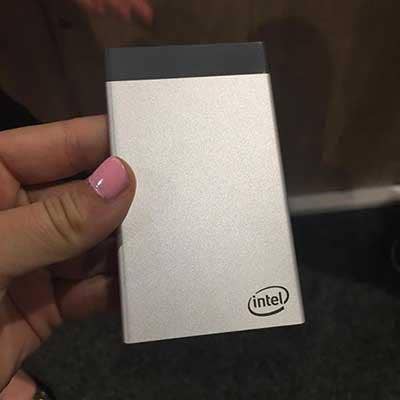
Embedded Computing From Contec
Contec, which makes industrial and embedded computers, showed its C5 embedded computer, based on Intel's Compute Card. The computer's modular design provides an upgrade path for embedded solutions that need I/O and regulatory stability, while also leveraging strong CPU performance. The embedded computer will be available as a solution in the third quarter of 2017, according to Contec.